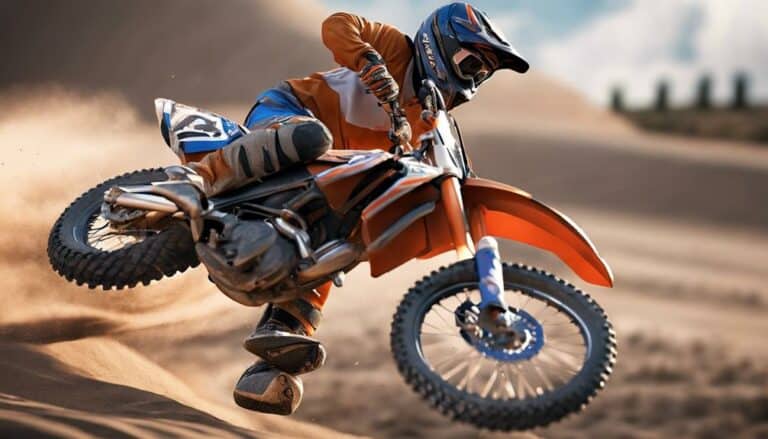When you hit the trails on your dirt bike, have you ever wondered how your body positioning impacts your stability and maneuverability?
The way you position yourself on the bike can make a significant difference in how well you handle tight corners, rough terrain, and sudden obstacles.
From shifting your weight to adjusting your posture, every subtle movement can affect how your bike responds to your commands.
So, next time you rev up your engine, consider how your body positioning could be the key to opening a smoother, more controlled ride.
Key Takeaways
- Gripping the bike with knees and leaning forward optimizes stability and control.
- Adjusting body position enhances maneuverability and traction on varied terrain.
- Leaning in turns shifts the center of gravity for improved balance and cornering ability.
- Proper body positioning is essential for precise control and navigating rough terrains with ease.
Importance of Proper Body Positioning
Proper body positioning on a dirt bike greatly enhances control, stability, and maneuverability, essential for safe and efficient riding. When riding off-road, maintaining correct body positioning is vital. Your body acts as a counterbalance to the bike, allowing you to navigate rough terrains with precision.
To achieve ideal balance, make sure your knees are gripping the bike firmly. This action not only stabilizes your body but also enhances your control over the bike. Leaning forward while gripping the bike with your knees helps maintain traction and balance, preventing unnecessary sliding.
Techniques for Enhanced Control
Enhance your control on a dirt bike by mastering key techniques for maximum maneuverability and stability. Gripping the bike with your knees while leaning forward is important for distributing weight effectively and maintaining balance. When turning, leaning in the direction of the turn helps shift the center of gravity, improving traction and control. It's important to adjust your body position based on the terrain you're riding on as this greatly impacts your ability to maneuver the bike.
To optimize maneuverability, consider techniques such as leaning your upper body in the direction of the turn and moving forward on the bike. These adjustments allow for greater control and agility when tackling challenging paths. Remember that different terrains require specific body positioning adjustments to ensure improved control and stability throughout your ride. By mastering these enhanced control techniques and making terrain-specific adjustments, you can elevate your dirt bike riding experience to new levels of proficiency.
Impact of Body Positioning on Stability
When positioning your body on a dirt bike, stability is greatly impacted by centering your body over the bike's pivot point. Proper body positioning plays a critical role in enhancing stability by optimizing weight distribution.
By gripping the bike with your knees and leaning forward, you can evenly distribute your weight, which improves balance and control. Adjusting your body position while riding, especially when leaning into turns, helps maintain stability and manage rough terrain effectively.
This strategic management of your center of gravity through correct body positioning not only increases control but also reduces the risk of losing balance on challenging surfaces. Mastering the art of adjusting your body position based on the riding technique and terrain is essential for improving balance and stability, allowing you to navigate varying speeds and maneuvers with confidence.
Optimizing Maneuverability Through Positioning
To optimize maneuverability on a dirt bike, gripping the bike with your knees and leaning in the direction of turns is essential for enhancing traction and control. This strategic body positioning allows for better weight distribution, increasing stability and control over the bike.
By adjusting your body in response to terrain conditions, you can greatly impact your overall maneuverability, making navigation through diverse landscapes smoother. Leaning your upper body towards the direction of turns not only improves cornering ability but also enhances your control over the bike, especially in challenging terrains.
Mastering the art of body positioning can lead to a remarkable 20% increase in maneuverability, making it easier to maneuver through tough terrain with confidence. Understanding the importance of body positioning, especially gripping the bike with your knees and leaning during turns, is vital for optimizing maneuverability, stability, and control while enhancing traction and cornering ability for improved navigation through varying terrain conditions.
Body Positioning for Varied Terrain
Properly adjusting your body positioning to match the terrain is important for maintaining stability and control while riding a dirt bike. When riding on different terrains, employing specific body positioning techniques can greatly enhance your maneuverability and overall riding experience. Here are some key terrain-specific adjustments to take into account:
- Weight Distribution: Gripping the bike with your knees and leaning forward helps distribute weight evenly, improving balance and stability across rough terrain.
- Center of Gravity: Leaning in the direction of turns shifts your center of gravity, enhancing traction and control by keeping the bike more planted on the ground.
- Adjusting Body Position: Making quick adjustments to your body position based on the terrain type can have a significant impact on your maneuverability and handling capabilities.
- Improved Balance: By mastering the art of leaning in turns and adjusting your body position accordingly, you can achieve improved balance and stability, allowing for smoother rides over varied terrain.
Conclusion
To sum up, mastering proper body positioning is essential for maximizing stability and maneuverability on a dirt bike.
By gripping the bike with your knees and leaning into turns, you can shift your center of gravity and improve control.
For example, imagine riding through a tight corner with precision and ease, smoothly leaning into the turn and feeling the bike respond effortlessly to your movements.
Perfecting body positioning won't only enhance your riding experience but also keep you safe on challenging terrains.

